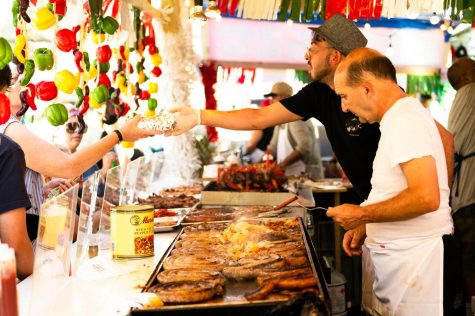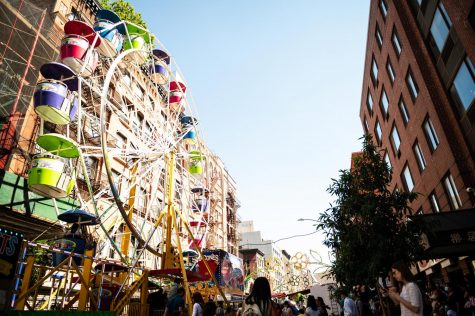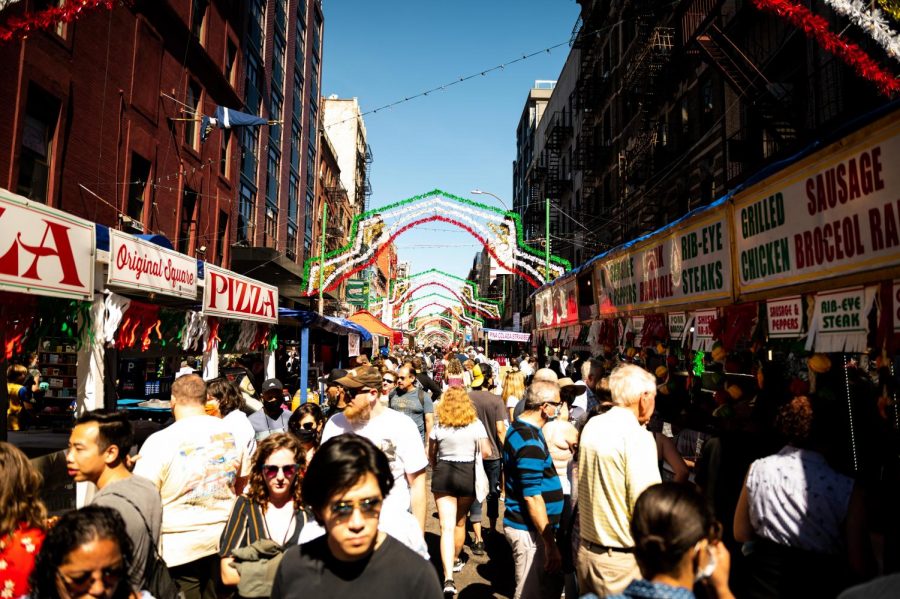The Feast of San Gennaro bodes ill for Little Italy
The shocking number of piña colada stations at the Feast of San Gennaro 2021 may reflect more than just a dying tradition.
Visitors crowd the Annual Feast of San Gennaro, held in Little Italy. Despite the name of the neighborhood, the Italian population in Little Italy has been decreasing and replaced by white collar workers. (Staff Photo by Jake Capriotti)
September 21, 2021
As a student dorming at Broome Street Residential College, right by Little Italy, I felt obligated to join in the crowd for the Feast of San Gennaro. I’d walked home the previous night on Mulberry Street, where all the action would be, under glistening red, white and green lights. I hoped the festival would give a somewhat authentic Italian experience.
You know it didn’t.
What began as a one-day block party in 1926 honoring Saint Januarius, the patron saint of Naples, has become a messy and tasteless 11-day tourist attraction with only a hint of Italian spirit. The Society of San Gennaro Naples’ and Suburbs Inc., an ostensibly non-profit organization, hosted the festival for 68 years until it was accused of mob influence and corruption in 1996. Its ownership was banned and transferred to Figli di San Genno Inc., which has since been on a mission to “save the feast” in terms of finance and management.

However, in seeking to attract more money, the festival has become a tourist trap. Instead of cannoli and zeppole, fried oreos festered. Instead of Campari and bellinis, piña coladas filled the street. Instead of carbonara and lasagna, tacos monopolized the scene. And I’m sure there’s a link between Republican mayoral candidate Curtis Sliwa’s visit to the festival and my struggle to find a sausage and peppers vendor without a MAGA hat. The organizer announced a Frank Sinatra tribute that day, but I wasn’t able to find the concert even after an hour of walking up and down Mulberry Street. Near the end of the feast, the humbly-sized statue of Saint Januarius presided over the official merch station.
Festival aside, Little Italy itself has become more little and less Italian than ever before. Historically, the neighborhood was home to tens of thousands of immigrants, most of them poor, and spanned 50 blocks from Houston to Worth Street at its start in the late 19th century. Today, it’s been reduced to a three-block area that houses an unclear number of Italians; in 2010, zero residents were born in Italy.
You must be wondering who is living in Little Italy now, if not Italians. The answer is white-collar workers with an average annual income of $278,448. These people are why rent has been increasing at more than twice the previous rates for historic restaurant owners. These people are why boutiques are replacing the pizzerias. These people are part of why the Feast of San Gennaro is as disappointing as it is today. And these people include us — Broome residents, and by extension, all NYU students.
For those of you who don’t know, NYU happens to be the wealthiest private landowner in New York City and the second-largest owner by number of addresses held, according to 2016 data. NYU added Broome to its portfolio in 2005 because it’s located in “the historic Little Italy and trendy SoHo neighborhoods.” The property is currently priced at $9,439,200, a small fraction of NYU’s $2 billion-worth of real estate, but acquiring it is a big step in the university’s journey toward gentrifying every Lower Manhattan neighborhood.
Even in its main role as an educational institution — rather than, you know, a real estate investor — NYU has not done enough to teach its students about gentrification and their participation in it. The university-sponsored and funded events, specifically at the other residence halls, should be aimed more at giving back to the communities that they are displacing. After all, it’s not just Little Italy that NYU is gentrifying but every neighborhood its reach extends to.
But then again, hall snacks are fun, fried Oreos are good and the decrepit Ferris wheel turned out to be magnificent. If you’re sick of Olive Garden, the Feast of San Gennaro provides the same quality and runs until Sunday Sept. 26.

Contact Alex Tran at [email protected].



























































































































































NYC Italian Mob • Oct 4, 2021 at 8:58 pm
I actually work for the mob and so I can say that all of you are wrong. Check your facts. Each ands every one of you knows nothing of Italia. I know Italia. In Italia we have a saying for people who comment on articles talking about wrong facts. We call them stupididous. You are all stupididous. Italia has always been and will always be Italia. I got a PHD in Italia.
BRooney • Sep 26, 2021 at 11:53 am
those poor residents that live on that very narrow street have to deal with this fake festival for stupid tourists that come to eat low quality junk food. nobody is speaking up for these residents when they have to breathe in all that carcinogenic smoke from all those coal grills whose fumes enter their apartments all day long day after day. where is their voice? how is this not a health concern issue> there are many elderly residents there that are disabled and cannot just walk out and rent a hotel room during this scam festival that disturbs the entire neighborhood.
Max • Sep 25, 2021 at 8:44 pm
To the author of this piece- your polemic hits a number of topical bases but seems to not possess any strongly coherent logic or consistent focus to it. To start- if the Italian populace of Little Italy is largely gone by now, why would authenticity be so important for this Festival? As a shrine to a world largely gone from that neighborhood? Impermanence, whether for better or worse, is a given in human existence. So- making the festival more ‘authentic’ again to somehow support a mostly-lost presence in the area seems a bit misplaced perhaps. The only feasible way to create a strong’ traditional’ ethnic festival in an area where little of that populace lives is presumably to have Disney or some other corporation skilled at such matters create a simulacrum of it- is that what you’d propose? Or that some entity somehow repopulate Little Italy with Italians and Italian-Americans and then properly re-launch the festival?
As for your concern about a republican presence at the event, my understanding is that there’s a very strong republican element in the Italian-American community, so it’s not clear to me why that would somehow detract from the authenticity of the event, regardless of whatever your political views or sensitivities are. It just seems like a sideswipe at republicans suddenly wandered into your discussion of another matter, and I say that as a liberal with no love or comfort with MAGA culture.
Your discussion then drifts into an indictment of NYU’s growth as a real estate investor and gentrifying influence in the city. So- are you somehow suggesting that this is primarily NYU’s fault that Little Italy is becoming less Italian, or that NYU should be somehow formally informing students about pre-gentrification Little Italy? There’s no detail on your part about what this would look like, so it ends up being a vague suggestion. Beyond that, while 2 billion dollars is a large sum, given that the property value in Manhattan alone is estimated as being close to two TRILLION dollars, I’m not entirely sure how strongly that supports the notion that NYU is having such a decisive effect upon the neighborhoods in question, versus larger macro-economic trends.
In sum, I’d say- enjoy your fried oreos, but brush up on your journalism/editorial skills.
Ted • Sep 25, 2021 at 10:30 am
This article sounds more like a critique about NYU and it’s property holdings. There are more facts about NYU than the SG Feast or the nieghborhood.
Lawrence • Sep 24, 2021 at 12:04 am
@Randy: isn’t saying that someone doesn’t “belong” somewhere (a vendor at a festival), by definition, predjuced?
Mickey O'Byrne • Sep 23, 2021 at 11:39 pm
This comments section has to be one of the funniest things I’ve read in a long time. You Italians with your rose-tinted glasses / straight up denial of, truly are something else. Go feast on some gabagool and chill out, paisans. Capisce, cannolis?
abel • Sep 23, 2021 at 8:35 pm
This has been and still is. my favorite outdoor feast anywhere in the world. I’ve been to everyone since the 90’s and never was disappointed. Yes i attended when men in designer suits stroll the strip.
It’s back this year and went twice. Not as crowded as the previous years but still was in a line to get my zeppoles and sausage and peppers.
My only disappointment this year is the concert. Missed cousin Brucie. Don’t agree much with this writer but that is opinion . I’m going tomorrow night.
Danielle Pugliese-DiRoma • Sep 23, 2021 at 8:46 am
I have to say that I have been going to the feast for 52yrs. And I do so on and off . In the 70’s & 80’s I would never miss a chance to go . Come 90’s on till present , it has changed so much . I was there this past Sunday and couldn’t wait to leave. I didn’t feel it was about my Italian heritage at all . It did feel more like a block party ! Yes the vendors were mixed as well as the crowd. I was walking around wondering where all my fellow Italians were ? Will not be going back ever. Really sad .
john abatilo • Sep 22, 2021 at 10:35 pm
It’s definitely not the same. We’ve been going every year for years. . Just keeps getting worse n worse. Usually we get a bus load and others taking cars or trains from RI. This year it’s down to a few of us. We drove to New Haven n took the Train. As always, Battery Park, Brooklyn Bridge, world Trade Center to the Feast.. No more Italian music filling the streets. I don’t think there was any Italian Music at all. 2 old guys playing the Scorpion but not for the Feast..PANHANDLERS! No more beer garden were everyone sang Italian singalong. Now the parking lot is a Condo. No more fun. Even people watching isn’t good anymore. Everyone walking dogs, smoking weed. Just not the same
Louis Bosso • Sep 22, 2021 at 7:39 pm
The Italian spirit is alive and well. The vendors and the local restaurants are just part of the atmosphere that everyone enjoys. Just look at the smiles on everyone’s face. Been going there since I was a kid and my kids love it. BTW. I lived in Broome St when it first opened in the late 1990s. Plus NYU leases the building, not owns.
Randy • Sep 22, 2021 at 5:32 pm
It is truly a shame what has taken place with this Festival I started going back in the early 70s it was great, and it gave me a lot of pride to be Italian.
Over the years it has deteriorated to a mix of Vendors that do not belong there a shame.
Basically Little Italy happens to be in the way of Chinatown taking it over.
Not prejudiced just staring a fact
Montez Wright • Sep 22, 2021 at 5:26 pm
Great piece! You are so right about everything you said. Its all about the money that whole area was taking over sometime ago. Of course its maybe a handful of italians down there but the majority of people living there are kids thats going half on them over priced apts down there and the other half are well off families. You are speaking the truth and keep up the good work!!!!!
Valerie V.- Goulet • Sep 22, 2021 at 4:17 pm
I am a decendant and all blessings to those who keep it going”! with love,to the positive people…!
Sean • Sep 22, 2021 at 12:50 pm
I thought the feast was amazing also seen with Italian Americans everywhere and Italians who knows if the immigrants or not but the feast was amazing I don’t know what you’re talking about but we had the best time ever at little mozzarella‘s stand it was a bunch of Italian comedians having fun smoking cigars eating Italian food just overall having a good all-time I don’t understand what part you want to or what night you want to buy again I’m from Long Island I loved it I’m going back again Saturday and I think it was the best feast it’s been in a long time actually and again I seen a lot of Italian people there yeah a lot of piña colada stands I’m not gonna lie but other than that there’s all walks of life everywhere you go it’s New York City think about what you’re saying ……..
Fred fiumefreddo • Sep 22, 2021 at 11:31 am
The feast was great. The food was good
The italian spirit is alive and well
For a feast that started yrs ago its still holding
It’s own. It will continue its tradition for
Yrs too come
John Fratta • Sep 22, 2021 at 11:15 am
First of all ,your journalistic integrity is zero. A good reporter checks their facts before you put it in print. You state no Italian born people still live there, wrong. I can give you names and have you meet them. Two, vendors with Mega hats, I walk back and forth at this feast and have not seen one yet. You talk about Curtis Sliwa and yes he has been here campaigning like so many other politicians do yearly. His presence has nothing to do with our feast. There is NO link between the Republican Party and our feast. Most of the members of our board are diehard Democrats. We are not and have never been political. Your statement that there was no Frank Sinatra Tribute is an outright lie. There was one and it was enjoyed by many who attended.
What you also omitted in you trash piece was the fact that since we took the reins of running the feast we gave over $2 million in charities. But your agenda was to attack our feast and not honest reporting, good job.
Joe Valentin • Sep 22, 2021 at 9:47 am
I’ve been hottie the feast since the 70’s always loved it , I moved to Miami for 30 years moved back to Brooklyn 4 years ago to Dyker heights couldn’t wait to go to the feast really missed it , as for the article yeah he must have been talking about another one this festival is still very much authentic the sausage and peppers, cannoli , funnel cake, pizza are still the mainstream of the feast was there Saturday and will be going for the closing I love NY.
Christina • Sep 22, 2021 at 9:40 am
This is a joke right ? of course there are not many immigrants in Little Italy anymore, but their descendants are living there. Most of them got smart and left the cess pool that is NY because they were tired of Cuomo and Deblasio’s shit. Rent is up not because of people make over $300k it’s because of the woke left demanding $15 minimum wage. Minimum wage goes up, cost of gas, food and living goes up as well. And as for the sausage and peppers vendors wearing MAGA hats and that’s why you didn’t go to them…..you’d go to them if they weren’t wearing them and you’d STILL be getting sausage from a patriot.
E Clifford Lazzaro Md • Sep 22, 2021 at 9:29 am
I am a graduate of NYU 1961 Bronx campus
My wife and I lived and practiced in Brooklyn
We brought our 5 sons and grandsons to the Feast of San Gennaro fir many many years Bd always enjoyed the experience.
One of our grandsons just reminisced about his fond memories growing up- how much he loved it all.
Hope the feast continues for many more years EcL
Marit • Sep 22, 2021 at 8:28 am
My husband and I love the Saint Gennaro festival and been flying to enjoy it along with other sightings
Glad to know it’s back ? I agree with the above positive comments n
Guestyyy • Sep 21, 2021 at 11:30 pm
I was at the feast last Fri. Curtis silva was there shaking some hands on the sidewalk. I saw him and waved to him and his group of guardian angels walking with him. That was the only red I saw all night. Not a single maga hat. I got a sausage and peppers sub from the big vins vendor tent. No red hats. And none on the numerous other vendors I passed. Not sure what feast you were at.
While the feast has expanded and become a bit touristy, it’s still the best festival hosted in Manhattan all year, and I’m glad it’s back. There’s tons of authentic Italian with some Pina colada and lemonade and empanda stands sprinkled in. This review seems very disingenuous. The only complaint I have about the feast is the price of games. Very nostalgic and I love playing, but they’re all $10 a play these days. Still played and won some plushies and had a great time. We’re going again this Fri and may try to make it on the last day if we can swing it.
Judi Barber • Sep 21, 2021 at 6:05 pm
Been going to the feast for over 50 years.
Yes has changed some but I was waxing nostalgic,
Since I remember how it was.
Apparently you have no nostalgia attached to this event,
Hence your negative review. My daughter and I loved it.
Ate at a restaurant bought Cannoles and biscotti.
Was given a free coal oven pizza.
I’ll be back. Was sad to read your review. That will kill the
Event going forward.
Marc Koppelman • Sep 21, 2021 at 3:28 pm
Alex,
Good piece about Little Italy & San Gennaro festival. As a kid growing up in Brooklyn, in a neighborhood where people with Italian heritage made up 90% of the population, I went to my first fair in 1948. I was 5 years old.
I went to the fair every year until I left the NY metro area to live in Montreal & oniy returned once to the fair to show my children the feast in 1990 . I too was disappointed with how it changed.
There were only 2 local businesses represented then, Ferara’s (sp?) Bakery & Vito’s Pizza. All the rest were from somewhere else. The atmosphere was different from my memories based on 30 years attending the fair. Additionally, it didn’t feel as safe, because it wasn’t being policed by the ‘mob’. (Check out the scene in the Godfather movie. Very much the same feeling as I experienced).
As for your tirade about NYU’s investment strategy to buy up real estate in the area & gentrify it is illogical & misplaced. I applaud the University. Instead of heavily investing in the stock market they use the money to insure that the area surrounding ‘campus’ remains stable. well kept and relatively safe for students & staff. You should check out the investment portfolios of other Universities & you find the same strategy at work. USC, Harvard, Carnegie Mellon, UPenn, Yale & Columbia just to name a few. The idea is sound, relatively safe & insures that the area surrounding the urban campus is well maintained & increases in value over time.
A good example of how this works is to look back at NYU’s history when they shut down the engineering campus in the 1960’s. The campus was located in the Bronx & it the area never recovered from the loss, right up to today. Check it out. It would make an interesting contrast to this story & maybe get you to realize the value NYU brings to the area.
Keep writing. I enjoyed your piece enough to respond.
Sincerely, Marc Koppelman, School of Education, Class of 1966.
JOhn Smith • Sep 21, 2021 at 1:29 pm
Broome Street was opened well before 2005 and NYU doesn’t own it. Need to check facts before writing your story.